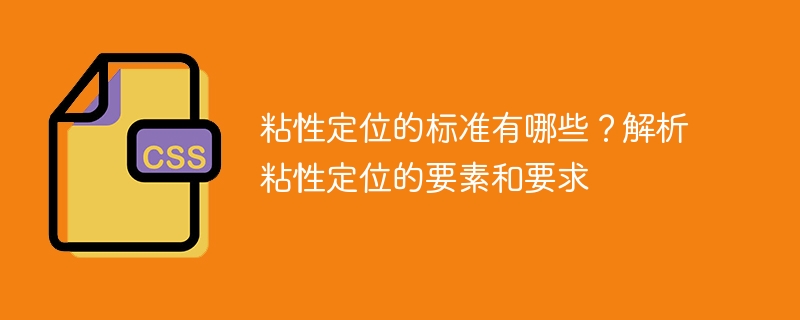Home >Web Front-end >CSS Tutorial >Standards for sticky positioning and analysis of elements and requirements for sticky positioning
Standards for sticky positioning and analysis of elements and requirements for sticky positioning
- 王林Original
- 2024-02-02 12:36:07651browse

Sticky positioning is a common web layout technique that provides a better user experience by keeping elements in a fixed position as they scroll. This article will analyze the standards, elements, and requirements for sticky positioning, and provide specific code examples.
1. Standards for sticky positioning
- Compatibility: Sticky positioning should work normally on mainstream browsers, such as Chrome, Firefox, Safari, etc.
- Scrolling effect: Elements should transition smoothly when scrolling to avoid flickering or jittering.
- Responsive design: Sticky positioning should adapt to different devices and screen sizes to ensure normal display at different resolutions.
- Accessibility: Elements should have appropriate keyboard navigation and screen reader support to ensure that users with disabilities can use them normally.
2. Elements of sticky positioning
- Positioning elements: elements that require sticky positioning, usually navigation bars, sidebars or floating buttons.
- Positioning position: The initial position of the element on the page and the fixed position when scrolling can be specified through the top, bottom, left, and right attributes of CSS.
- Scrolling container: The container the element scrolls relative to, which can be the scrolling of the entire page or the scrolling of a specified container.
- Trigger condition: when the element triggers sticky positioning, usually when the element scrolls to a specific position or triggers after a certain period of time.
3. Requirements for sticky positioning
- CSS compatibility: Use CSS properties and values supported by browsers for sticky positioning, avoid using experimental or only supported by some browsers properties.
- JavaScript support: If you need to dynamically change the sticky positioning properties of elements, use JavaScript to manipulate the DOM and styles.
- Performance Optimization: Avoid using too many sticky positioning elements to reduce page rendering and redrawing overhead.
- Compatibility processing: Provide alternatives for browsers that do not support sticky positioning, such as using fixed positioning or fixed layout.
4. Code Example
The following is a simple code example that shows how to use CSS to implement a sticky positioning navigation bar:
HTML code:
<!DOCTYPE html>
<html>
<head>
<title>粘性定位示例</title>
<link rel="stylesheet" type="text/css" href="styles.css">
</head>
<body>
<div class="content">
<nav class="sticky-nav">
<ul>
<li><a href="#section1">Section 1</a></li>
<li><a href="#section2">Section 2</a></li>
<li><a href="#section3">Section 3</a></li>
</ul>
</nav>
<section id="section1">
<h2>Section 1</h2>
<p>Content goes here...</p>
</section>
<section id="section2">
<h2>Section 2</h2>
<p>Content goes here...</p>
</section>
<section id="section3">
<h2>Section 3</h2>
<p>Content goes here...</p>
</section>
</div>
</body>
</html> CSS code (styles.css):
.content {
height: 2000px;
padding-top: 50px;
}
.sticky-nav {
position: sticky;
top: 0;
background-color: #eaeaea;
padding: 10px 20px;
}
.sticky-nav ul {
list-style-type: none;
margin: 0;
padding: 0;
}
.sticky-nav ul li {
display: inline-block;
margin-right: 10px;
}
.sticky-nav ul li a {
text-decoration: none;
color: #333;
}
section {
height: 500px;
margin-bottom: 50px;
}With the above example, the navigation bar (sticky-nav) will be fixed above the page when scrolling to the top of the element, providing a simple navigation experience.
Summary:
As a common web page layout technology, sticky positioning has standards such as compatibility, scrolling effect, responsive design and accessibility. Elements include positioning elements, positioning positions, scroll containers and trigger conditions. During the implementation process, attention needs to be paid to CSS compatibility, JavaScript support, performance optimization and compatibility processing. Through the above code examples, you can better understand and apply sticky positioning technology.
The above is the detailed content of Standards for sticky positioning and analysis of elements and requirements for sticky positioning. For more information, please follow other related articles on the PHP Chinese website!

